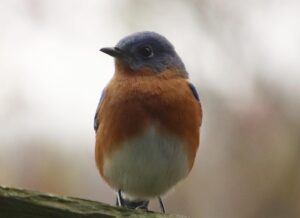 Last week it rained for about 48 hours, it seemed, and we got almost 7 inches total at the Nature Preserve. The Frog Pond rose, making the dock look like a floating dock, surrounding the willows, before overflowing on Mahan Lane.
Last week it rained for about 48 hours, it seemed, and we got almost 7 inches total at the Nature Preserve. The Frog Pond rose, making the dock look like a floating dock, surrounding the willows, before overflowing on Mahan Lane.
 The waterfall is still full almost a week later, but as you walk down along Little Huckleberry Creek, you may slide a bit on the muddy trail. The raging current of the high water washed soil away from the roots of many flowers growing close to the bank. Then you see the bridge, covered by debris, which certainly backed up the water at its height.
The waterfall is still full almost a week later, but as you walk down along Little Huckleberry Creek, you may slide a bit on the muddy trail. The raging current of the high water washed soil away from the roots of many flowers growing close to the bank. Then you see the bridge, covered by debris, which certainly backed up the water at its height.
 But walk on over to the Hidden Spring Trail, where debris rushing downstream actually pushed a bridge off its foundation. Many of the trails leading down to Little Huckleberry are suffering from erosion damage. Rainfall intensity is the primary determinant of erosivity, with higher intensity rainfall generally resulting in more erosion. The size and velocity of rain drops is also an important factor. Larger and higher-velocity rain drops have greater kinetic energy, and thus their impact will displace soil particles by larger distances than smaller, slower-moving rain drops. The composition, moisture, and compaction of soil are all major factors in determining the erosivity of rainfall. Sediments containing more clay tend to be more resistant to erosion than those with sand or silt, because the clay helps bind soil particles together. Soil containing high levels of organic materials are often more resistant to erosion, because the organic materials create a stronger, more stable soil structure. The amount of water present in the soil before the precipitation also plays an important role, because it sets limits on the amount of water that can be absorbed by the soil (and hence prevented from flowing on the surface as erosive runoff). Wet, saturated soils will not be able to absorb as much rain water, leading to higher levels of surface runoff and thus higher erosivity for a given volume of rainfall. Soil compaction (as on a trail) also affects the permeability of the soil to water, and hence the amount of water that flows away as runoff. More compacted soils will have a larger amount of surface runoff than less compacted soils.
But walk on over to the Hidden Spring Trail, where debris rushing downstream actually pushed a bridge off its foundation. Many of the trails leading down to Little Huckleberry are suffering from erosion damage. Rainfall intensity is the primary determinant of erosivity, with higher intensity rainfall generally resulting in more erosion. The size and velocity of rain drops is also an important factor. Larger and higher-velocity rain drops have greater kinetic energy, and thus their impact will displace soil particles by larger distances than smaller, slower-moving rain drops. The composition, moisture, and compaction of soil are all major factors in determining the erosivity of rainfall. Sediments containing more clay tend to be more resistant to erosion than those with sand or silt, because the clay helps bind soil particles together. Soil containing high levels of organic materials are often more resistant to erosion, because the organic materials create a stronger, more stable soil structure. The amount of water present in the soil before the precipitation also plays an important role, because it sets limits on the amount of water that can be absorbed by the soil (and hence prevented from flowing on the surface as erosive runoff). Wet, saturated soils will not be able to absorb as much rain water, leading to higher levels of surface runoff and thus higher erosivity for a given volume of rainfall. Soil compaction (as on a trail) also affects the permeability of the soil to water, and hence the amount of water that flows away as runoff. More compacted soils will have a larger amount of surface runoff than less compacted soils.
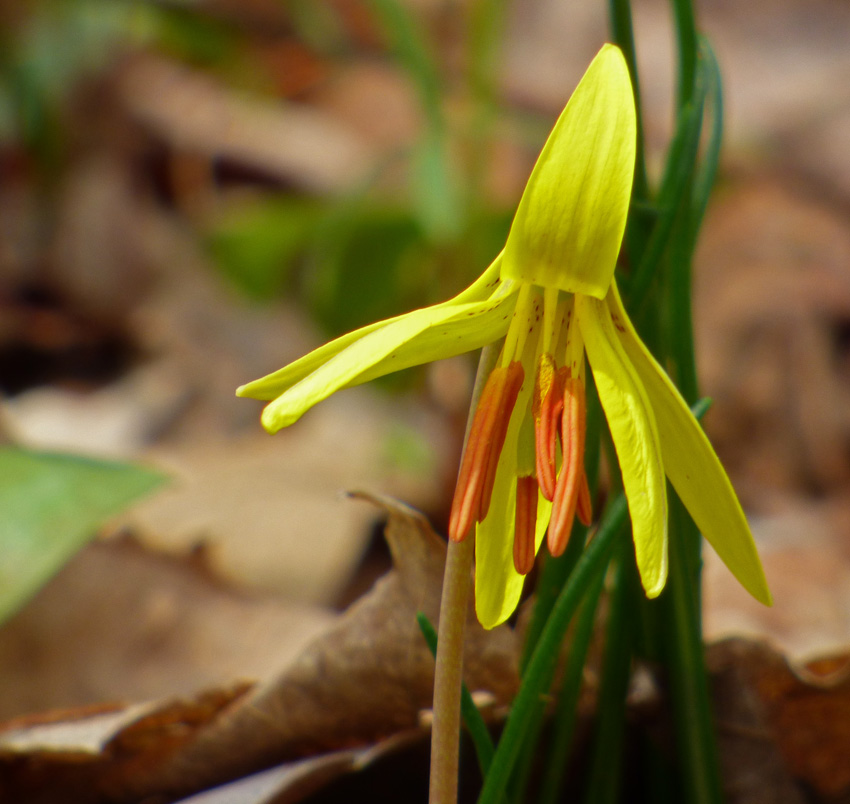 Despite concern about the flood damage, the wildflowers bring joy to our hearts! Yellow Trout Lily grow in patches in which all the plants are clones. The single leaf plants make and store food, while only the two leaf plants bloom. These small (4 – 6″ tall) members of the lily family can put on quite a show when a cluster of them in the garden is in full flower. These lilies take seven years to mature and when mature have two mottled basal leaves. The flowers have six tepals (three sepals and three petals) and open during the day (to the extent that they are recurved when fully open) and close at night (to protect the pollen on the showy reddish or yellow anthers.) These are deep rooted plants and roots can go 8″ deep and you must have highly organic or sandy-loam soils for these species to thrive.
Despite concern about the flood damage, the wildflowers bring joy to our hearts! Yellow Trout Lily grow in patches in which all the plants are clones. The single leaf plants make and store food, while only the two leaf plants bloom. These small (4 – 6″ tall) members of the lily family can put on quite a show when a cluster of them in the garden is in full flower. These lilies take seven years to mature and when mature have two mottled basal leaves. The flowers have six tepals (three sepals and three petals) and open during the day (to the extent that they are recurved when fully open) and close at night (to protect the pollen on the showy reddish or yellow anthers.) These are deep rooted plants and roots can go 8″ deep and you must have highly organic or sandy-loam soils for these species to thrive.
Be sure to join our Spring Wildflower Walks with Tavia Cathcart Brown- Saturday, April 19, 10 a.m. – 2 p.m. Tavia will talk about wildflowers at an Indoor Wildflower Presentation – 10:00 a.m., followed by a Woodland Garden Walk (easy) – 11:00 a.m., and the Wildflower Trail Walk (moderate) – 12:15 p.m.
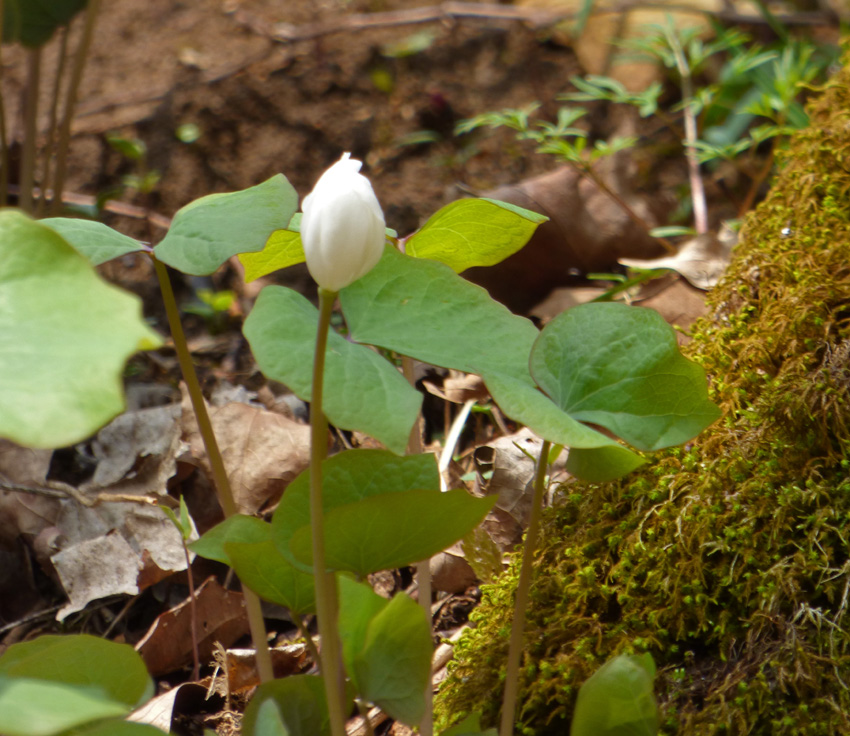 According to the Kentucky Native Plant Society, Twinleaf is uncommon to rare in Kentucky, Tavia says, but we have hillsides full of it at the Nature Preserve. It seems to bloom at mid-day when the sun is the brightest.
According to the Kentucky Native Plant Society, Twinleaf is uncommon to rare in Kentucky, Tavia says, but we have hillsides full of it at the Nature Preserve. It seems to bloom at mid-day when the sun is the brightest.
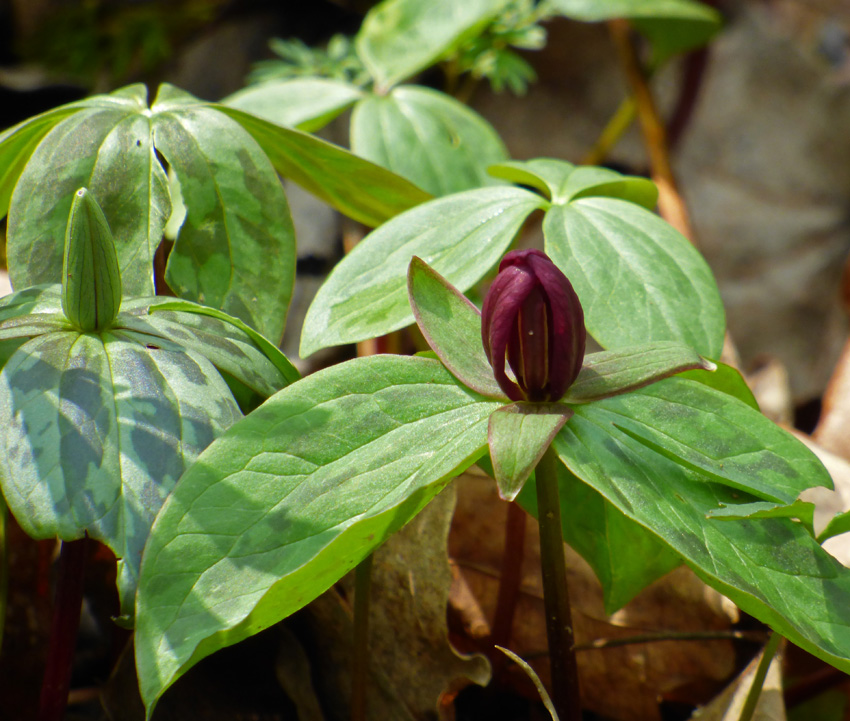 Sessile Trillium is the only kind of naturally growing Trillium along Little Huckleberry Creek. Look carefully because they are much smaller than you would expect. The “tri” in their name indicates that all parts come in threes – three leaves, three sepals and three petals with no stems. In the woodland garden you can find other varieties as well.
Sessile Trillium is the only kind of naturally growing Trillium along Little Huckleberry Creek. Look carefully because they are much smaller than you would expect. The “tri” in their name indicates that all parts come in threes – three leaves, three sepals and three petals with no stems. In the woodland garden you can find other varieties as well.
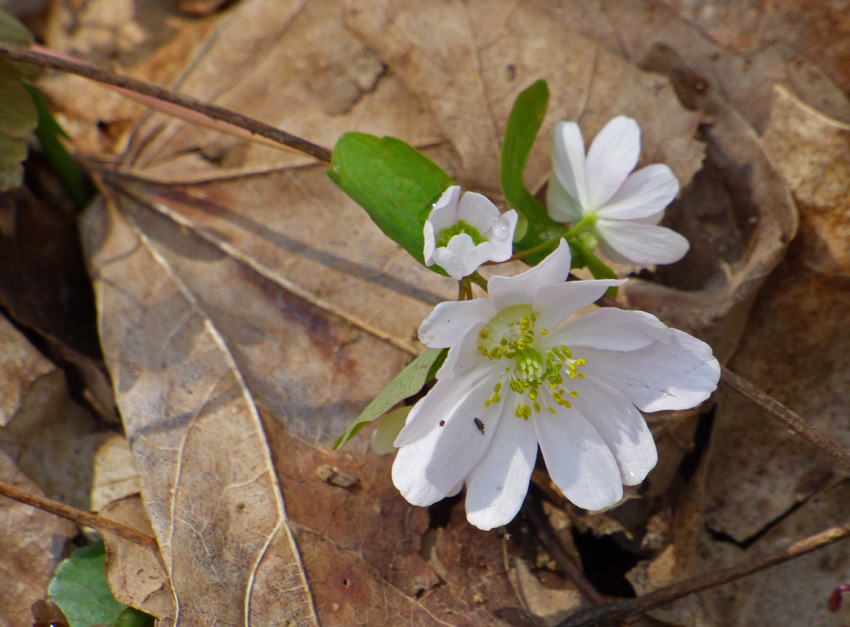 Both the “true” Rue Anemone and “false” Rue can be found on the hillsides of Little Huckleberry Creek. The “true” Rue has seven to ten petals, and waves in the slightest breeze. Compare these blossoms to the brown leaves under them – they are very small blooms.
Both the “true” Rue Anemone and “false” Rue can be found on the hillsides of Little Huckleberry Creek. The “true” Rue has seven to ten petals, and waves in the slightest breeze. Compare these blossoms to the brown leaves under them – they are very small blooms.
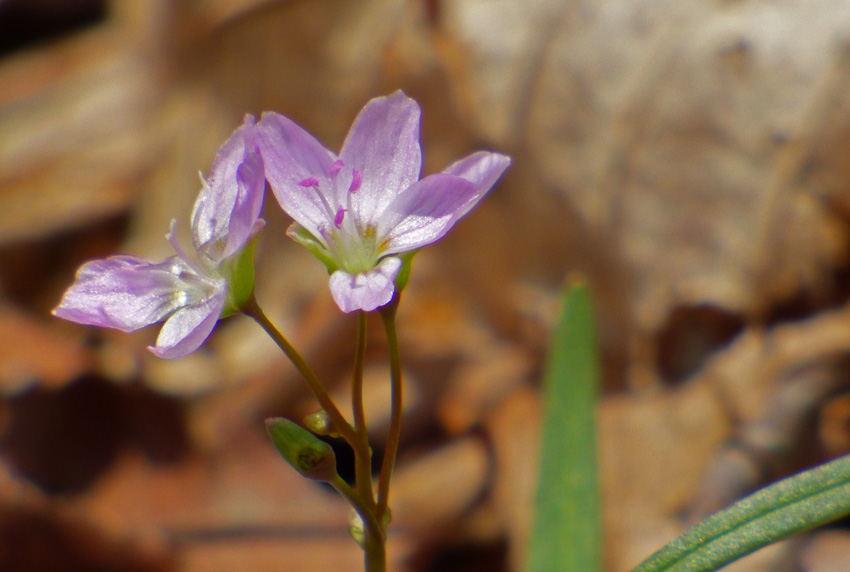 Don’t miss the little pink Spring Beauties! Tavia says they actually have pink pollen!
Don’t miss the little pink Spring Beauties! Tavia says they actually have pink pollen!
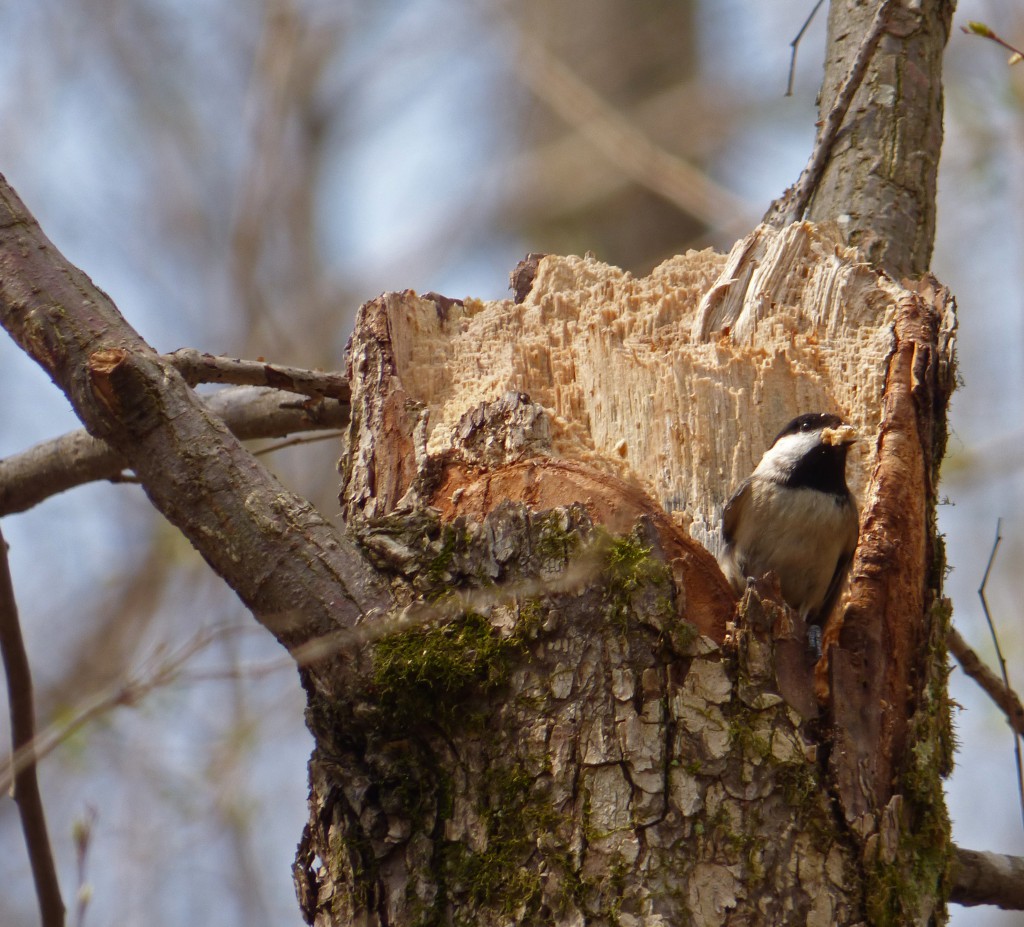 Tavia and I spent a delightful few minutes watching a pair of Carolina Chickadees enlarging a cavity in the top of a tree snag. I never knew they could tear out pieces of wood like a woodpecker! They sometimes take the easier route of moving into one of our Bluebird nest boxes instead of using a natural cavity. A video of them can be found on our website. Isn’t Spring wonderful! I take photos of the same flowers each year, but never tire of them. Each is prettier than the other!
Tavia and I spent a delightful few minutes watching a pair of Carolina Chickadees enlarging a cavity in the top of a tree snag. I never knew they could tear out pieces of wood like a woodpecker! They sometimes take the easier route of moving into one of our Bluebird nest boxes instead of using a natural cavity. A video of them can be found on our website. Isn’t Spring wonderful! I take photos of the same flowers each year, but never tire of them. Each is prettier than the other!

